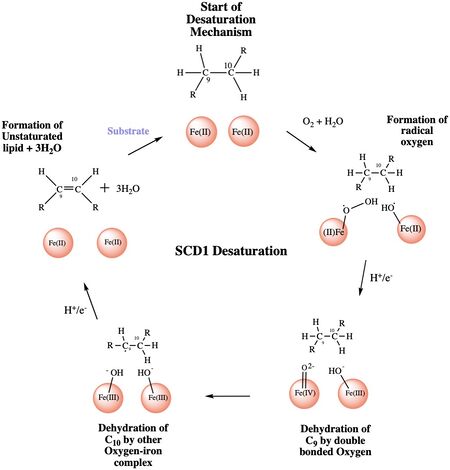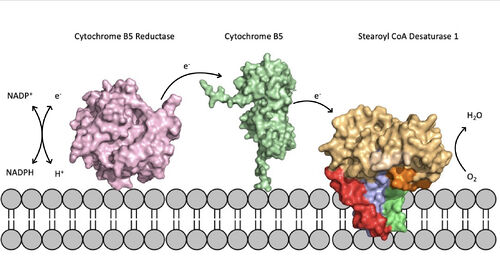User:Jacob Holt/Sandbox 1
From Proteopedia
(Difference between revisions)
| Line 10: | Line 10: | ||
SCD1 is a [https://en.wikipedia.org/wiki/Transmembrane protein transmembrane protein] (4 helices in membrane, 8 helices in cytoplasm) that acquires electrons via an electron transport chain which includes [https://en.wikipedia.org/wiki/Cytochrome_b5_reductase cytochrome b5 reductase] and [https://en.wikipedia.org/wiki/Cytochrome_b5 cytochrome b5] . The electrons are transferred via a ternary complex and accepted by SCD1 by the iron metal ions<ref name="Shen" />. SCD1 has 8 helices that are hydrophobic, 4 helices that are hydrophilic, and 3 helices that are amphipathic<ref name="Bai" /><ref name="Shen" />. There are two Fe+2 metal ions within the structure of SCD1 that were determined by x-ray fluorescence chromatography [https://en.wikipedia.org/wiki/X-ray_fluorescence x-ray fluorescense]<ref name="Shen" />. [[Image:colorful2.jpg|200 px|thumb|left|Figure 3. Hydrophobicity of each of the 12 helices found in SCD. red, blue, yellow, and green represent helices found in the transmembrane region. Orange helices represent helices found on the surface of the membrane. Pale yellow helices represent the hydrophilic helices.]] [[Image:colored_helices.jpg|420 px|right|thumb|Figure 4. Colored helices based on hydrophobicity. Red, green, yellow, and blue represent the transmembrane helices. Orange represents the helices found on the surface of the membrane, and tan represents the helices found in the cytoplasm.]] | SCD1 is a [https://en.wikipedia.org/wiki/Transmembrane protein transmembrane protein] (4 helices in membrane, 8 helices in cytoplasm) that acquires electrons via an electron transport chain which includes [https://en.wikipedia.org/wiki/Cytochrome_b5_reductase cytochrome b5 reductase] and [https://en.wikipedia.org/wiki/Cytochrome_b5 cytochrome b5] . The electrons are transferred via a ternary complex and accepted by SCD1 by the iron metal ions<ref name="Shen" />. SCD1 has 8 helices that are hydrophobic, 4 helices that are hydrophilic, and 3 helices that are amphipathic<ref name="Bai" /><ref name="Shen" />. There are two Fe+2 metal ions within the structure of SCD1 that were determined by x-ray fluorescence chromatography [https://en.wikipedia.org/wiki/X-ray_fluorescence x-ray fluorescense]<ref name="Shen" />. [[Image:colorful2.jpg|200 px|thumb|left|Figure 3. Hydrophobicity of each of the 12 helices found in SCD. red, blue, yellow, and green represent helices found in the transmembrane region. Orange helices represent helices found on the surface of the membrane. Pale yellow helices represent the hydrophilic helices.]] [[Image:colored_helices.jpg|420 px|right|thumb|Figure 4. Colored helices based on hydrophobicity. Red, green, yellow, and blue represent the transmembrane helices. Orange represents the helices found on the surface of the membrane, and tan represents the helices found in the cytoplasm.]] | ||
| - | === Ligand Binding Pocket === | ||
| + | |||
| + | |||
| + | |||
| + | |||
| + | |||
| + | |||
| + | |||
| + | |||
| + | |||
| + | |||
| + | |||
| + | |||
| + | |||
| + | |||
| + | |||
| + | |||
| + | |||
| + | |||
| + | |||
| + | |||
| + | |||
| + | |||
| + | |||
| + | |||
| + | |||
| + | |||
| + | |||
| + | |||
| + | |||
| + | |||
| + | |||
| + | |||
| + | |||
| + | |||
| + | |||
| + | |||
| + | |||
| + | |||
| + | |||
| + | |||
| + | |||
| + | === Ligand Binding Pocket === | ||
The ligand binding pocket is a narrow tunnel that extends approximately 24 Å into the mostly hydrophobic interior of the protein. The ligand is stabilized by bending into a kinked conformation which creates a tight fit in the binding pocket tunnel, and by a hydrogen bond that occurs between the W258 side chain and the acyl carbonyl<ref name="Bai" />. The kink in the tunnel is formed by the conserved residues, <scene name='87/877552/Desaturation_site/8'>T 257 and W 149</scene><ref name="Bai" />.7 which are stabilized by the hydrogen bond shared with Q143<ref name="Bai" />. There are <scene name='87/877552/Substrate_orientation_w_fe/5'>two Fe2+ ions</scene> that interact with the substrate; the Fe2+ ions are coordinated by 9 histidine residues. One metal ion is coordinated by 4 histidines residues and a water molecule, and the other metal ion is coordinated by 5 histidine residues<ref name="Bai" />. <scene name='87/877552/Substrate_oreintation_fe_90deg/2'>When rotated 90 degrees</scene> the ligand is seen to be in a eclipsed position, indicating it is in its post-reaction form. The histidines residues position the metal ions 6.4 Å apart<ref name="Bai" />. | The ligand binding pocket is a narrow tunnel that extends approximately 24 Å into the mostly hydrophobic interior of the protein. The ligand is stabilized by bending into a kinked conformation which creates a tight fit in the binding pocket tunnel, and by a hydrogen bond that occurs between the W258 side chain and the acyl carbonyl<ref name="Bai" />. The kink in the tunnel is formed by the conserved residues, <scene name='87/877552/Desaturation_site/8'>T 257 and W 149</scene><ref name="Bai" />.7 which are stabilized by the hydrogen bond shared with Q143<ref name="Bai" />. There are <scene name='87/877552/Substrate_orientation_w_fe/5'>two Fe2+ ions</scene> that interact with the substrate; the Fe2+ ions are coordinated by 9 histidine residues. One metal ion is coordinated by 4 histidines residues and a water molecule, and the other metal ion is coordinated by 5 histidine residues<ref name="Bai" />. <scene name='87/877552/Substrate_oreintation_fe_90deg/2'>When rotated 90 degrees</scene> the ligand is seen to be in a eclipsed position, indicating it is in its post-reaction form. The histidines residues position the metal ions 6.4 Å apart<ref name="Bai" />. | ||
Revision as of 21:20, 23 April 2021
Desaturation of Fatty Acids using Stearoyl-CoA Desaturase-1 Enzyme
| |||||||||||
Student Contributions
Carson Maris, Jess Kersey, Jacob Holt





